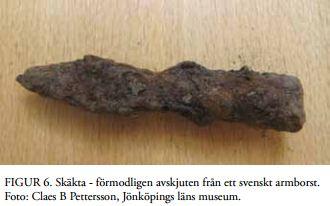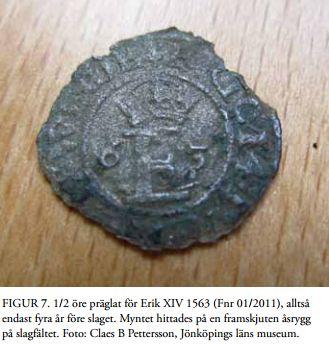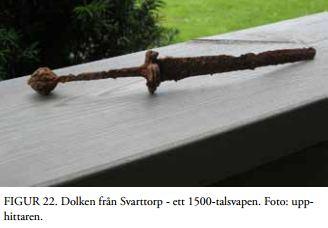16th Century Campaign Archaeology
Martin Rundkvist
Source - http://scienceblogs.com/aardvarchaeology/

...Sweden fought the Northern Seven Years' War from 1563 to 1570 against Denmark-Norway, Lübeck and the Polish-Lithuanian union. The war ended in mutual exhaustion, with nobody gaining any territory - which was what wars were fought for at the time. So even at the time there was no way to justify the loss in lives, homes and livelihoods, though the Danes did get to sell the stronghold of Älvsborg (and Sweden's access to the Atlantic) back to the Swedes at a steep price.

In the autumn of 1567, Danish general Daniel Rantzau headed a surprise attack on the then Swedish border province of Småland with an army of about 6000. His objective was to lay the province waste and force the Swedes to the negotiation table, in sort of a miniature Hiroshima move. On 31 October Rantzau's vanguard under Christoffer von Dohna reached a small wooden fort defended by about a thousand Swedes under Peder Kristersson Siöblad and blocking the Danish advance. After a brief skirmish the fort was taken and the Swedes retreated with severe losses. The skirmish bought them time to destroy an important causeway across a bog and evacuate and torch the city of Jönköping, which Rantzau would otherwise have made his army's winter quarters.

The site of the skirmish and the fort was soon forgotten. But enough detail is given in Rantzau's campaign memoir that local historian Harry Bergenbladh could point with some confidence to a likely spot in 1967. He, however, had no realistic way of testing his hypothesis as metal-detector battlefield archaeology had not yet been developed. This was remedied in 2010 when Claes Pettersson and his collaborators went out to test the waters. They found the heads of crossbow bolts, a Katzbalger short sword used by Landsknech tmercenaries in close combat and a 1563 Swedish coin. Fieldwork in 2011 added musket balls, pistol bullets, a spur and a horse bit, all in topographical situations that make sense in the context of how Rantzau describes the fighting. The Swedish sites and monuments register now contains its first 16th century skirmish site!

The report and the fieldwork don't end there. The group has also done geophys on the site of a nearby church village that went up in smoke the morning after Rantzau's army had bivouacked there, performed some less successful metal detecting on the poorly preserved site of another skirmish, documented relevant finds in private ownership locally, and mapped the smoking corridor of devastation that the Danes left behind by means of taxation registers from the period following the war. All in all a wide-ranging and innovative piece of Early Modern campaign archaeology produced on a slender budget!

Engkvist, S. et al. 2012. Getaryggen 1567. Delrapport för år 2011. Miliseum rapport 2011:1. Skillingaryd.